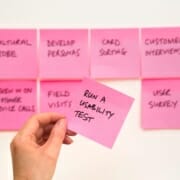What to Include in Mobile App User Testing Processes
Mobile apps have grown by leaps and bounds, providing limitless possibilities and affording capabilities like communication, productivity, entertainment – and beyond. With millions of apps in AppStore and PlayStore, developers face fierce competition to design apps that stand out, provide unique solutions to customers, and build evergreen applications that answer both the current problems and future challenges.
This is exactly where mobile app user testing comes into play.
Why User Testing?
In the highly competitive market of mobile apps, user testing is the linchpin in mobile app development that separates apps that succeed and those that fail. User testing helps developers determine how well an app resonates with the target audience, providing an operating benchmark for improving the features and creating superior apps. The mobile app user testing is the differentiating factor between an app’s conception and its overall usability.
The central purpose of user testing is to ensure that an app functions as intended and provides an intuitive user experience.
Here’s precisely why user testing is crucial:
- User-centered design. Mobile app testing helps you understand and map your user needs in your development. In essence, testing identifies your users’ pain points, behavior, preferences, and options – and integrates these needs into the app.
- Bug detection. While extensive pre-launch testing is crucial for identifying underlying errors in code, it’s nearly impossible to detect every usability issue without real-life testing. User testing uncovers these problems before they reach your target audience.
- Improved retention. An intuitive, error-free, and user-friendly app is likely to attract more users, which leads to a competitive advantage in the app’s adoption and use. Apps that attract and retain users perform better in a dynamic competitive market than apps without retention rates.
- Enhanced ratings. When your app is optimized for best use, it’s likely to feature better and more positively, increasing its likelihood of adoption and use. Conversely, negative reviews from poor customer experiences can affect your app’s success.
- Cost-efficiency. Fixing your app’s underlying issues pre-launch is more cost-effective and less time-consuming than fixing the issues during the development stage. User testing helps to identify real usability issues before they reach the market, resulting in more cost savings in fixing errors and bugs.
So, whether you’re developing an Android app or an iOS app, mobile app user testing is a critical process of overall development. User testing is the linchpin of successful mobile app development.
So, in the next section of this article, we will discuss some factors, elements, or things to include in your mobile app user testing processes, providing you with correct, accurate, and relevant information to know when conducting user testing.
USE OUR APP COST CALCULATOR TO ESTIMATE THE COST TO BUILD YOUR APP!
1. Prepare for user testing
Before embarking on the user testing journey, it’s crucial to lay a solid foundation for the process, ensuring you have the right tools, the right infrastructure, and processes. The first step of this process is to define your goals, laying a foundation for what you seek to achieve after the process. While these goals and objectives differ depending on the different stages of the mobile app development, they should generally capture the following goals:
- Usability assessment. This step determines the app’s ease of use and overall user-friendliness.
- Functionality testing. To ensure all features and functionalities work as intended in harmony.
- Performance evaluation. To assess how the app performs under different situations and circumstances.
- User satisfaction. This testing gauges user feedback and satisfaction with the app’s functionality and usability.
Articulating these points upfront allows you to create a roadmap that guides your testing efforts and ensures you gather the relevant information to make the right decisions.
2. Set up the testing environment
Setting up the testing environment is a crucial step to ensure you achieve the best results. A well-prepared environment ensures you can assess how your app performs in different situations and ensure that it mimics real-life scenarios.
Here’s how to achieve the right testing environment:
- Device diversity. Endpoint and mobile devices come in different shapes, sizes, and operating systems. So, choose a representative sample covering the most commonly used devices by your target audience.
- Operating systems. Consider the different varieties of operating systems and testing on both new and old operating systems as users may have different challenges or constraints accessing newer versions.
- Emulators and simulators. While mobile phones, tablets, and laptops are essential, use emulators and simulators to expand your testing coverage without acquiring every device.
It’s also crucial to ensure you have the right tools and technologies for the testing process. Here are some of the testing tools you can use for this process.
- Testing tools. When it comes to testing tools, it’s advisable to invest in automated testing tools such as Espresso, Appium, and XCUITest. In addition, performance testing tools such as Firebase Performance Monitoring and Apache JMeter can help evaluate your app’s responsiveness and speed.
- Remote testing services. You should consider remote testing services if your audience spans multiple geographic regions. These services provide you with remote access to global testers who can assess your app’s performance on their devices and operating environments.
- Bug tracking and reporting. Implement a robust bug-tracking system that allows testers to detect and report issues immediately. Popular bug-tracking tools include Trello, Bugzilla, and Jira. Efficient bug tracking can help increase an app’s usability, performance, and responsiveness.
Having the right tools and technologies and selecting the best technologies and software allows you to establish the conditions needed to conduct meaningful and thorough mobile app user testing.
3. Conduct user testing
The process of conducting user tests is at the heart of mobile app development. This process involves giving real users your app to test its functionality, usability, responsiveness, and security.
Here’s a detailed breakdown of how to conduct user tests:
- Usability testing. This process involves exploring how responsive and navigable your app is. It helps you identify navigation issues, responsiveness problems, and where users may face glitches. This type of testing ensures your app is easy to use and aligns with your users’ expectations.
- Functionality testing. Functionality testing assesses how your app functions. It helps detect errors, bugs, and hitches that may prevent consumers or users from browsing seamlessly. Functionality testing ensures key aspects of your app operate as required.
- Other testing types. Depending on your app’s scope and complexity, you may need to conduct other tests such as security tests, performance, and localization testing. Each test plays a fundamental role in ensuring your app functions as intended.
As you test your app, it’s crucial that you establish test detectors to guide you through the testing process. Guide testers include the following three elements;
First, provide testers with defined test scenarios that comprehensively cover your app’s functionality. The scenarios provided should align with real-life use cases or match the objectives set during the planning phase.
The second step of your testing is to communicate instructions clearly and concisely and explain the tasks testers should perform and the objectives they should attain. Avoid questions or biasing suggestions that may influence the tester’s behavior.
The third step is documentation. It’s vital to ensure the testers have relevant documentation such as boarding guides and manuals, which allows them to understand the app’s features and functionalities.
4. Gather user feedback
Once user testing is complete, the next step is to gather structured and unstructured feedback and observations from your testers. This section of the article discusses the steps that you should follow to draw better insights from collected feedback.
The first step is to analyze, organize, and categorize the responses by reviewing all the feedback given by the testers. Collect feedback and recommendations collected during the process, recording notes, comments, and recordings of user interactions.
Secondly, categorize the comments, notes, and responses into groups based on common issues and themes. This form of categorization helps identify patterns and prioritize relevant areas of improvement.
The final step is analyzing and categorizing both qualitative and quantitative data. The quantitative data include: response rates, success rates, and task completion rates and qualitative data include observations and user comments. Analyzing these two subsets of data provides an end-to-end understanding of user feedback, allowing you to know what areas to improve.
After gathering user feedback, it’s advisable to prioritize and document identified issues and bugs, which allows you to map usability problems. You can prioritize and document issues based on issue severity, create a detailed report with a priority list of issues; and finally assign a priority ranking to each issue, identifying how much of a priority each usability issue is in the whole process.
5. iterative testing and improvements
Iterative testing is the secret ingredient for successful mobile app creation. This section of the article discusses iterative testing, the process of developing an app, the importance of addressing issues promptly, and how to make improvements based on user feedback.
- Continuous process. In testing your mobile app, it’s crucial to understand the iterative nature of mobile apps. Therefore, mobile app testing isn’t a one-step process; it has to be cynical, evolving with the emerging needs of users and consumers.
- Feedback. Each testing cycle introduces a new set of feedback for the proceeding steps or stages of the testing. This feedback loop ensures that the app evolves and adapts to the ever-changing user needs, preferences, and values.
- Agile methodology. Most developers use agile methodology by incorporating user testing as a fundamental step of the development process. Agile methodology promotes feedback, collaboration, and flexibility, accommodating different user feedback in the design process.
Iterative user testing and improvements help address issues promptly, helping you deal with user expectations. When developing your app, you will realize that users have many expectations about an app’s performance and responsiveness. Failing to address these issues promptly may lead to negative reviews and frustrations that impede your app’s adoption and market reputation.
Another reason to incorporate feedback and continuous improvement through the agile methodology is because of the competitive landscape. The tech industry is a highly competitive marketplace. Addressing issues can be a significant differentiator. Apps that address user feedback and incorporate feedback tend to retain new and existing users, providing the developer with a competitive edge.
Lastly, addressing issues is part and parcel of quality assurance. Timely response or simply responsiveness can go a long way in setting you apart in quality assurance, ensuring your apps and products meet the requisite benchmarks. By resolving bugs and usability issues promptly, you reduce the risk of app abandonment.
SCHEDULE A CONSULTATION WITH AN APP DEVELOPMENT EXPERT TO GET A CUSTOMIZED QUOTE!
6. Security and data privacy testing
The increasing sophistication of cyber-attacks and the growing prevalence of cyber incidents continue to compromise users’ data and the integrity of user information. As mobile apps become more interconnected with our everyday-use devices – laptops, wearables, tablets, and other endpoints, so is the need to protect these endpoints from potential abuse or intentional compromise.
As part of your mobile app user testing process, emphasize the importance of security and data privacy testing. We cannot over-stress the significance of protecting the integrity of consumer private information.
- User trust. Users trust apps that are secure and protected. Loss of trust can lead to severe consequences including; reputational damage, loss of users, and lawsuits.
- Legal compliance. Breach of trust can lead to legal liabilities, leading to hefty fines and penalties. Complying with established laws like the GDPR and HIPAA guidelines is crucial to ensure your app remains relevant.
- Financial implications. Loss, breach, and potential breach of consumer private data may have far-reaching financial consequences, including loss of revenues, brand damage, and legal fines.
Security and data privacy testing ensure that developers provide and leverage the best-in-class security systems, including encryption, patching, and detection tools to create robust and highly secured applications.
NS804 – Your Trusted Provider of Mobile App Solutions
NS804 is a trusted provider of custom-built mobile app solutions for businesses of different sizes and shapes. Whether you’re a manufacturing shop floor, a retailer, an e-commerce store, or a hospitality facility, we can help you reclaim your digital victory with custom-built mobile apps that give you that digital presence.
NS804 secures the future of its applications with reliable and secure applications that meet the highest security and testing requirements. We work collaboratively with talented and competent teams of developers, security experts, quality assurance, and engineers to ensure we provide secure and trusted mobile app products.
Contact NS804 today for mobile app development solutions.

 https://www.pexels.com/photo/woman-sitting-beside-table-while-using-ipad-2265482/
https://www.pexels.com/photo/woman-sitting-beside-table-while-using-ipad-2265482/








 https://unsplash.com/photos/bMTl6uFMONg
https://unsplash.com/photos/bMTl6uFMONg
Leave a Reply
Want to join the discussion?Feel free to contribute!